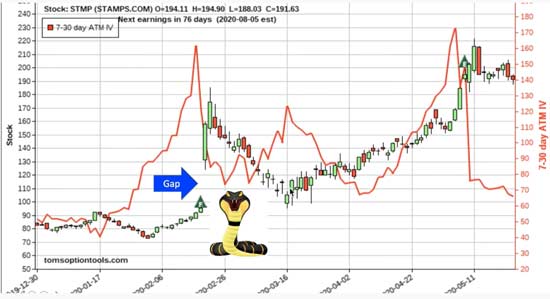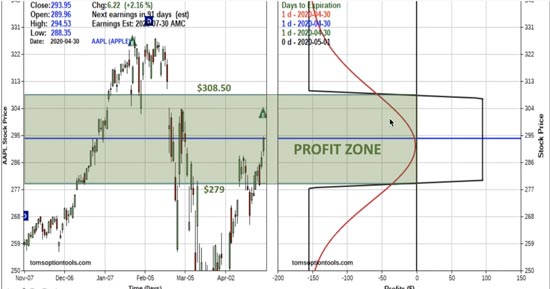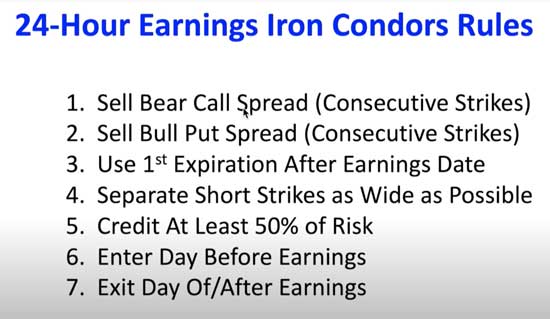Oh, boy... the honey badger. A small-ish, totally fearless, almost insanely vicious predator that's notorious for not giving a... you-know-what.
Honey badgers have been seen to take on - and kill - all kinds of animals, including plenty you'd have to be plain crazy to tangle with at its size.
Venomous cobras... lions... Cape buffalo... African "killer" honeybees... even people; the honey badger has taken them all on and walked away. It definitely deserves the catchphrase, "Honey badger don't care."
Who better to learn from as we become better traders?
This strategy will have you fearlessly targeting big, fast gains you might otherwise think you couldn't touch...
A High-Probability 24-Hour Earnings Play
What I call the "honey badger trade" is known by another name out there - maybe you've heard of it: the "iron condor."
We've talked about implied volatility (IV) a few times before, and it's one of the keys to this kind of trade. As a quick review, IV is the measurement of the expected volatility of the underlying stock over the life of an options contract.
It directly reflects the supply and demand for the option, and it's a pretty good indicator of where the market thinks the stock price will go.
IV impacts the premium you receive or pay to sell or buy an option.
Like honey badgers, IV is the "food" we're hunting.
The big spikes you see in this screencap are spikes in the IV of Stamps.com Inc. (NASDAQ: STMP). And if you guessed that those green "E" triangles are earnings announcements, you're right.

What this strategy aims to do is to capitalize on those spikes in IV, to sell expensive options one day, and to buy them back when they're really cheap the next day, as the IV plummets.
But, like the honey badger, sometimes we've got to contend with a deadly cobra...

The cobra in this case is a sudden gap up or down in the stock price even as IV drops. That big move in a stock price can "kill" you in this trade... unless you're prepared to survive it.
This kind of move seems to happen often with Stamps.com, so you want to pick a stock with little to no history of gapping during earnings.
That's where the 24-hour iron condor comes in. We used this strategy over the spring with Apple Inc. (NASDAQ: AAPL).
An iron condor is a lot like the "butterfly" trade, which we talked about not long ago, but it's got much wider "wings." It's also a mix of bearish and bullish trades - a bear call spread and a bull put spread - all on the same stock and all expiring on the same day.
In fact, you're trading options that expire the next day, right after the earnings announcement or other big, IV-moving event you're expecting.
Specifically, you're buying a call with a higher strike price and selling a call with a lower strike; you're selling a put with a high strike and buying a put with a lower one. Make sure the distance between the two options in each spread is the same.



Now, it's important to talk about risk awareness and money management here.
The difference between the two strike prices minus the credit you get for entering the trade is your risk. Here, it would be $1.50, or $150 for 100 contracts.
And you definitely want to arrange your position sizing so that your maximum risk is at or beneath your maximum position size threshold (talk to your broker or licensed money manager to work out what's best for you).
That way, should the cobra get lucky and the stock gaps in a big way, (i.e., the trade moves against you), you take a 2% or 3% hit to your account and live to fight another day.
But even if the stock gaps a bit, as long as the price stays in the "breakeven" range of $279 to $308.50, you walk away counting your 66%-plus, one-day profits.
Exiting an iron condor is surprisingly easy, too - you simply sell what you bought and buy what you sold.
Here's a quick look at the iron condor rulebook:

Just like a honey badger, you go in, beat the cobra, and get back out with your winnings.
And in the meantime, I'm going to reveal my most lucrative options trading secret yet...
It's the reason I'm able to make such fast, profitable moves on companies like Netflix, Facebook, or even Amazon; it's the reason I'm able to see major paydays long before they happen.
And believe it or not, it's as easy a few simple clicks of your mouse. Click here to see...
Follow Money Morning on Facebook and Twitter.
About the Author
Tom Gentile, options trading specialist for Money Map Press, is widely known as America's No. 1 Pattern Trader thanks to his nearly 30 years of experience spotting lucrative patterns in options trading. Tom has taught over 300,000 traders his option trading secrets in a variety of settings, including seminars and workshops. He's also a bestselling author of eight books and training courses.



